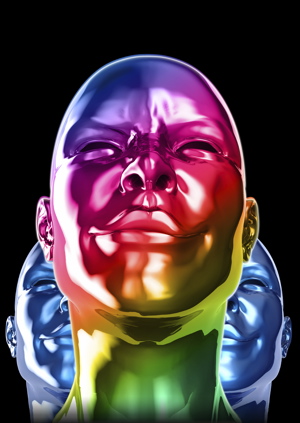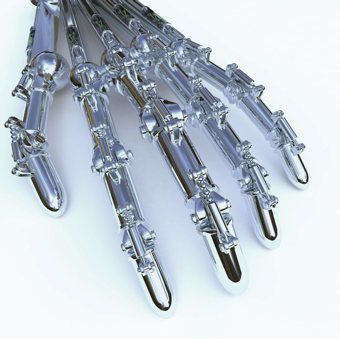A magazine where the digital world meets the real world.
On the web
- Home
- Browse by date
- Browse by topic
- Enter the maze
- Follow our blog
- Follow us on Twitter
- Resources for teachers
- Subscribe
In print
What is cs4fn?
- About us
- Contact us
- Partners
- Privacy and cookies
- Copyright and contributions
- Links to other fun sites
- Complete our questionnaire, give us feedback
Search:
Robots: the rise of the machine
Sohaib Mohammad, Ismael Anoba, Henry Nganga, Lawrence Nunoo and Beverley Osazemwinde, students at Queen Mary, University of London, have been looking into the impact of artificial intelligence and robots on our lives: past, present and future.
What's in a name
Artificial Intelligence (AI) is gradually becoming a major part of our lives...often without our noticing. To understand how and why, we must first ask ourselves what exactly it is...

Is AI the thing we see in Science Fiction books and movies, or is that just fiction? It's a research area that combines several subjects including computer science, psychology, physiology, and philosophy. It's made up of different fields, ranging from machine vision to expert systems. The element they all have in common is the aim of creating machines that can 'think'. Humans have been intrigued by the idea of thinking machines for a very long time, but only now is the dream of smart machines gradually becoming a reality.
Robot rules?
Many science fiction writers have used their imaginations to transport us both to worlds where humans live in peace with robots, like 'I Robot', and to ones where humans fight them - remember 'Matrix 3'? In fact the science fiction writers have often helped drive the reality. Where did the idea of robots surpassing the abilities of their human masters come from? Partly from fiction. The best known author is Isaac Asimov. He placed robots and their interaction with society at the centre of his stories. He also (in the original 'I, Robot') invented the Three Laws of Robotics.
1. A robot may not injure a human being or, through inaction, allow a human being to come to harm.
2. A robot must obey orders given to it by human beings except where such orders would conflict with the First Law.
3. A robot must protect its own existence as long as such protection does not conflict with the First or Second Law.
These apparently simple rules led in the stories to a wide range of dilemmas that robots had to deal with and perhaps will in the future. Robots will apparently need ethics!
In the Beginning
So much for fiction. What has been achieved so far?
Researchers have created systems that can mimic human thought, understand speech, beat the best human chess player, and achieve countless other feats. AI researchers, are ever more upbeat about the possibilities. For example, here are Turing Award winner, Herbert Simon's thoughts:
"It is not my aim to surprise or shock you - but the simplest way I can summarise is to say that there are now in the world machines that can think, that can learn and that can create. Moreover, their ability to do these things is going to increase rapidly until - in a visible future - the range of problems they can handle will be coextensive with the range to which the human mind has been applied." - Herbert Simon quoted in Daniel Crevier's book "AI", .
During the 1990's we witnessed a boom in the mass-production of basic Artificial Intelligences aimed at the domestic market both for education and leisure. Many people, including children, have now been introduced to AIs as a result of the many different kinds of AI products flooding onto the market. For kids this meant must-have Tamagotchis, Giga Pets, Furbies and Aibo, a domestic robotic dog.
Don't Believe the Hype!
Intelligent machines originally emerged as a potential reality when a group of visionaries led by John McCarthy introduced the idea at the 'Dartmouth conference' in 1956. They believed that they could quickly create a machine with a mind as intelligent as a human being.
1956: "machines will be capable, within twenty years, of doing any work a man can do" - Herbert Simon:
1967: "Within a generation ... the problem of creating artificial intelligence will substantially be solved." - Marvin Minsky
Their ideas gave birth to Artificial Intelligence as a mainstream research area. Unfortunately, fuelled by their belief, they made predictions like those above that failed to match reality. The real early 'thinking machines' could actually only do simple tasks, and barely deserved the label 'intelligent' at all. The ultimate result was that the funding dried up and the growth of AI slowed to a crawl.
The problem was that there were many problems that the early AI pioneers failed to foresee. They did not anticipate the computer power required do these challenging tasks. The subsequent period was known as the AI winter. Could their early hype before they could even start to deliver, and the subsequent loss of research funding, be a reason why AI has not leapt already to the heights of science fiction films?
Back to the Future
In the 80s AI went commercial and money was poured in once more. In particular the area of 'expert systems' was born. Expert systems use banks of rules combined with logic to make both predictions and decisions. The larger storage capacity available by the 80s meant computers could hold large knowledge bases allowing the expert systems to grow big enough to become of practical use. They are now used very widely in the stock market, aiding doctors to diagnose disease, and to point miners at promising mineral location.
Robots on the rise (again)
Robotics also started to come into its own as computers became more powerful. In 1996 Honda unveiled the P-2 (prototype 2), a humanoid robot that could walk, climb stairs and carry loads. Money poured in. Why? There are many jobs that humans just do not want to do. The job may be dangerous like exploring a volcano or just plain tedious like vacuuming the living room.
Robots provide accuracy over repetitive tasks. They can be programmed to repeat a particular task over and over without the need for breaks doing exactly the same operations every time. Take the Da Vinci system. It is a surgical robot that eliminates the hand tremors of surgeons during long periods of surgery.

Robots can also work in hostile conditions. For example, MAARS (modular advanced armed robotic system) is an advanced military robot capable of carrying a machine gun or robotic arm. It is faster than its predecessors and is also equipped with software that eliminates the possibility of friendly fire.
Robots can collect and analyse information. Military robots such as the Dragon eye unmanned aerial vehicle, for example, does this. It is a small aircraft equipped with a camera that enables it to analyse the enemy position. Dragon eye was apparently used to scout enemy's positions in Iraq.
Robots can make precise measurements and do complex calculations faster than a human being. The Da Vinci system, for example, can do heart operations making only three small incisions in the chest. Each is only around a centimetre across. This enables the patient to recover rapidly.
Menace 2 society?
Right now robots have not reached a level of development where they pose a threat to society. The many films and books on the topic suggest this may one day change with their common theme of the robots' intelligence and abilities exceeding humans. They become conscious and then decide to overpower the human race.
There's no doubt that robots would be a danger if they were programmed to kill, so presumably the only reason why this hasn't happened yet is because of human decency.
Of course malicious programming is a big problem. There are many viruses, trojan horses and the like circulating on the Internet causing immense problems. What happens when Internet connected robots start to become infected by prankster's programs?
Even without malicious programming, a robot moving freely in a human environment is dangerous. If your best friend stood on you foot it might hurt but you would be all right. What if a robot of the same size stepped on your foot? You would need to go to Accident and Emergency at the very least!
A slightly different fear is that if the rise of robots continues and they are able to do ever more complex tasks then they may replace us in the workplace, leaving many humans without jobs. This has already started to happen with factory workers. The more efficient robotic machines have taken over in areas such as the car industry.
The development of computer systems with or without artificial intelligence and robotics was always bound to affect the employment market. This just shows our society adjusting to yet another change. There will probably always be a high demand for creative artists, designers and technicians but at the same time the employment market for semi-skilled or low skilled employment will clearly decline.
There are other disadvantages of robotics as a whole. Let's return to Robotic surgery to examine a concrete example to see how it may not all be rosy.
As we saw, medical robots were developed to solve the problems human surgeons were facing with minimal invasive surgery. In robot-assisted surgery instead of the surgeon moving the instruments and equipment themselves they use a computer console. The surgeon's movements are then carried out on the patient by the 'Robodoctor'. The instruments are actually attached to a series of robot arms. The use of robot invasive surgery reduces patient recovery time as the incisions are very small. It also allows the surgeons to have better control over the surgical instruments.
However, such robots are very expensive to buy, run and maintain. Robotic-assisted heart surgery can take nearly twice the amount of time that typical heart surgery takes. This is a serious disadvantage as the longer the surgery, the longer the patient is under the anaesthetic and also the more it will cost for the (human) support staff. Other problems include the fact that as the technology is new, existing instruments and equipment are not compatible with the new robotic systems. Furthermore, the size of the robots mean they could require larger operating rooms.
All happy together?
In reality it looks like the robots are here to stay. So are they bad or good? Despite the many films and books depicting robots as our sworn enemies and our successors in the evolutionary chain of life, so far there is little evidence that robots are really a threat to mankind. They are no where near to achieving consciousness never mind gaining a desire to rule the world. On the other hand we already live in a society that is dependant on machines with all their benefits as well as their costs. Robots can be an aid to our society because of the many tasks that they can carry out that we may not be able or wish to do.
The ultimate future may not in any case be an either/or between humans and robots. We leave you with the real story of Claudia Mitchell. At the age of 26 she lost her left arm in an accident. As a result she became the world's first bionic woman ... or at least the first to receive a bionic arm, that can be controlled by thought alone. "I can open a jar. I can hold my Dagwood sandwich. I can hold fruit and vegetables while I cut them up. I can peel a banana", Mitchell said. It makes her daily life so much easier. The future: human and robot?
More on robots
Interview with Kerstin DautenhahnThis article is an edited version of an essay written for the Computers and Society course at Queen Mary, University of London.


